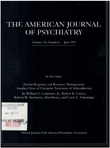Trauma-related symptoms in veterans of Operation Desert Storm: a preliminary report
Abstract
OBJECTIVE: This study was designed to examine prospectively the development of trauma-related symptoms over time in two reserve units of Operation Desert Storm veterans. METHOD: One month and 6 months after returning from the Persian Gulf area, 84 National Guard reservists, from one medical unit and one military police unit, completed questionnaires on their exposure to combat and to specific stressors and rated the severity of their symptoms of posttraumatic stress disorder (PTSD) on two different scales. Differences in symptom severity at the two time points were analyzed. RESULTS: Scores on the Mississippi Scale for Combat-Related Post-Traumatic Stress Disorder, but not severity ratings on a symptom scale based on DSM-III-R PTSD criteria, increased significantly from the 1-month to the 6-month rating time. At both time points, symptoms of hyperarousal were more severe than symptoms of reexperiencing or avoiding trauma-related events. Level of exposure to combat, as reflected by the Combat Exposure Scale and a Desert Storm trauma questionnaire, was significantly associated with score on the Mississippi PTSD scale. There were no significant differences in combat exposure and PTSD symptoms between the male and female subjects or between the medical and police units. CONCLUSIONS: These preliminary findings suggest that a high percentage of Desert Storm veterans experienced some trauma- related symptoms after returning to the United States. Six months after the war, these symptoms, although relatively mild, had not significantly improved in this study group as a whole. For research on longer-term outcome, follow-up of these 84 reservists continues.
Access content
To read the fulltext, please use one of the options below to sign in or purchase access.- Personal login
- Institutional Login
- Sign in via OpenAthens
- Register for access
-
Please login/register if you wish to pair your device and check access availability.
Not a subscriber?
PsychiatryOnline subscription options offer access to the DSM-5 library, books, journals, CME, and patient resources. This all-in-one virtual library provides psychiatrists and mental health professionals with key resources for diagnosis, treatment, research, and professional development.
Need more help? PsychiatryOnline Customer Service may be reached by emailing [email protected] or by calling 800-368-5777 (in the U.S.) or 703-907-7322 (outside the U.S.).



